Real SaaS business growth is all about predictability.
If you can predict your revenue (accurately), you can make better decisions around expenditure, new hires, and investment in product development.
To be able to predict your revenue accurately, you need to be able to predict sales pipeline growth, which ultimately relies on two SaaS marketing metrics:
- Deal close rate
- New lead acquisition
If you know how many new leads your company gets each month, and you know the percentage of those leads you can expect to become paying customers, then you can predict your revenue.
From there, if you can improve and increase your lead generation, you'll inevitably grow your revenue.
Unfortunately, lead generation can be one of the biggest SaaS marketing challenges there is. You could use outbound lead generation services, but we want to show you the knowledge required to continue this journey with your team and not a third party.
This article will explore what SaaS lead generation is, the steps for effective B2B SaaS lead generation, and what to consider before setting up your strategy.
What Is SaaS Lead Generation?
You can think of SaaS lead generation as the mystical art of converting strangers into potential customers with automation tools and a few clicks. It's like being a wizard, but instead of waving a magic wand, you're waving your mouse and keyboard around, conjuring leads from the depth of the internet.
Imagine this; you're a SaaS company with a revolutionary software product that will change the world (or at least make someone's job a little easier.) The organization's team, tech, and brains are in place, but now you're missing one key ingredient: prospects.
Enter SaaS lead generation!
What Are the Different Categories of SaaS Lead Generation?
First, Define Your Goal
What does a ‘lead' mean to you?
Is it someone interested in purchasing? Is it an email subscriber? Is it someone who likes or shares a post on LinkedIn?
SaaS marketers typically work with a few different types of leads, so it's important to clarify what qualifies as a lead and what doesn't. You might even be targeting different kinds of leads in different campaigns, so you'll want to be able to distinguish between them.
This is especially important in SaaS marketing for startups, as failing to do so can lead to a lot of confusion and inaccurate growth predictions.
SaaS leads are typically divided into three categories:
- Information Qualified Leads (IQL)
- Marketing Qualified Leads (MQL)
- Sales Qualified Leads (SQL)
As you've probably noticed, these three categories represent three different levels of customer intent.
Information Qualified Leads
IQLs are often referred to as ‘cold leads.' They are at the beginning of the buyer journey, at the Awareness stage. They are typically prospects who've come across your top-of-funnel content (blogs, eBooks) and have become a lead by handing over an email address in exchange for more valuable information (such as subscribing to your blog or downloading an e-book).
Marketing Qualified Leads
MQLs are in the Consideration stage of the customer journey and may be referred to as ‘warm leads.' That is, they are closer to purchasing than IQLs, but not as hot as SQLs. The prospect has continued to express their interest in your product. They've probably watched a few webinars, downloaded some whitepapers, and considered your company an option for solving the issues they are facing.
Sales Qualified Leads
These are the kinds of leads we all want, but the cold hard truth is you generally have to start with IQLs, nurturing the leads through to a point where they are SQL or ‘hot lead.' Prospects that are SQLs are in the Decision stage of the buying cycle and ready to make a decision.
This is typically where a salesperson gets involved (hence they are sales-qualified leads), offering a bottom-of-funnel type offer (such as a free demo or trial) and aiming to close the deal.
|
Lead Type |
Strength |
Customer Journey Stage |
Example |
|
Information Qualified Leads (IQL) |
Cold lead |
Awareness |
Prospect subscribed to your blog |
|
Marketing Qualified Leads (MQL) |
Warm lead |
Consideration |
Prospect has expressed continued interest |
|
Sales Qualified Leads (SQL) |
Hot lead |
Decision |
Prospect has reached out for a free trial or demo |
What Makes SaaS Lead Generation Different?
Filling your SaaS sales pipeline with scheduled appointments or booked demonstration calls is the primary goal of SaaS lead generation. Locating the key stakeholders in businesses within your target audience lets you get started on the right foot when initiating the first discovery call.
However, B2B SaaS organizations may have various pricing models and acquisition strategies for their software solutions, including but not limited to the following:
- Risk-free paid trials
- Freemium tiers
- Paid subscriptions
- Free trials
SaaS lead generation for B2B companies is a time-consuming process spanning multiple months. Depending on data from past campaigns, the target market, and other marketing strategies, it generally takes a few quarters to unfold quantifiably. Following SaaS best practices, such as making customer success an early priority for the business, helps increase the chances of getting the results you want sooner.
Steps for Effective B2B SaaS Lead Generation
Set SMART Goals
Setting SMART goals is like having a roadmap for your SaaS lead generation efforts, guiding you to success with purpose and clarity. These objectives focus on specific, measurable, achievable, relevant and time-bound goals, making them the perfect recipe for a winning strategy.
Having the perspicacity to know what you want to accomplish, rather than vague aspirations like “get more leads,” can be an excellent way to achieve your desired outcome.
Dive into figures concerning the target audience, how many leads you aim to generate, and what you want them to do after they've become a prospect (convert to paying customers, of course.)
Develop a Marketing Persona or Personas
When creating marketing personas for SaaS lead generation, it's essential to consider various aspects such as demographics, job roles, pain points, goals, challenges, and buying behaviours. By understanding these details, you can tailor your messaging, content, and marketing campaigns to address your target audience's specific needs and preferences.
Having well-defined marketing personas enables you to better align your lead generation strategies with the needs and motivations of the target audience, resulting in more qualified leads and increased chances of conversions. Regularly reviewing and updating your personas based on feedback and data can ensure that marketing efforts stay relevant and effective in generating leads for the SaaS business.
Generating Leads Through Content
Content marketing is the future of marketing.
In fact, content marketing is the now of marketing as well.
SaaS marketers have an abundance of content tactics at their disposal, but if you start with just these three, you'll be well on your way to winning:
- Blogging
- Gated Content
- Webinars
SaaS Blogging
Blogs have kind of come full circle. They were all the rage in the 90s and quickly became ‘uncool' shortly after.
Today, it seems everyone has a blog on their website. In fact, there are over 70 million blog posts published every month on WordPress websites alone.
But to see real success in SaaS blogging, you've got to go further than just hashing out low-quality articles and publishing on a semi-regular basis. You've got to make sure your blog aligns with your SaaS marketing goals.
You need to be consistent, and you've got to do it with purpose. Remember, your goal is to generate leads. The only way you're going to turn a reader into an opportunity is to provide such incredible value that they are literally begging for more.
Ask yourself these questions:
- Am I clear on my audience, and is this post aimed squarely at them?
- Do I have keyword data with enough search volume to justify writing this blog post?
- Does this article provide clear, actionable insights?
- If I were the reader, would I be so impressed that I'd hand over my email address for more?
If the answer to any of the above is no, then your blog isn't ready to post (or your topic idea does not need to be written).
Check out HubSpot's blog for an example of how to do things right. Not only do they post so regularly we don't even have time to read it all, everything they write has a clear customer persona and gives the reader real, actionable value.
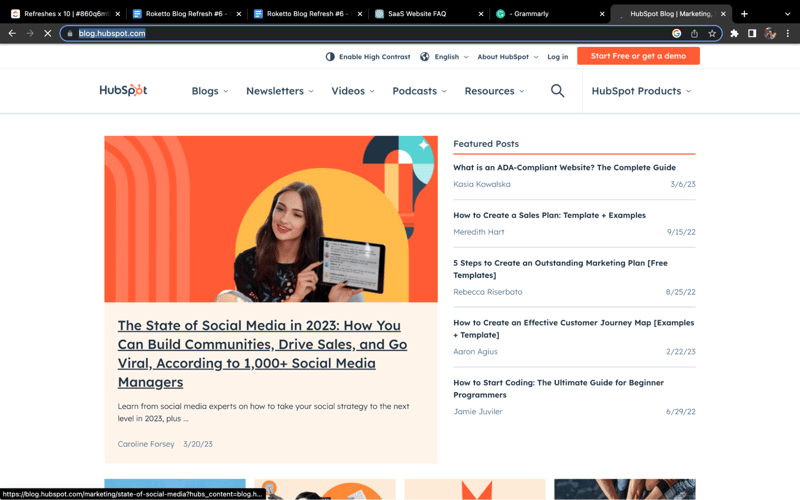
Gated Content
Gated content is all about trading information. You're offering something extremely valuable, such as an eBook, in exchange for a prospect's information (usually an email address).
Now, with so many valuable, in-depth blog posts and videos out there on the internet for free, how exactly can you expect prospects to hand over their email address for it?
The trick is in providing value that they just can't get anywhere else. You're even more likely to win if you've already demonstrated your incredible expertise, which is why you'll so often see this tactic used on SaaS blog pages.
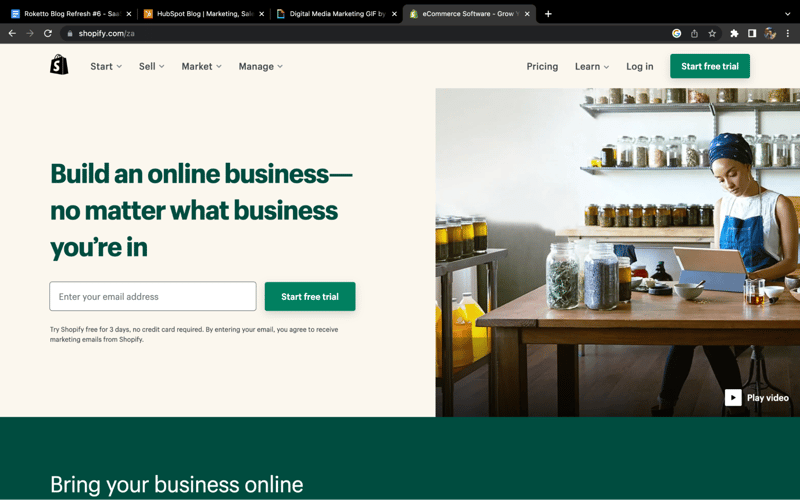
This is an example of gated content from Shopify, positioned above the fold on their blog page.
How could anyone say no to that? Free. Business. Lessons.
By offering incredible value such as this in exchange for only an email address, you can very easily build a huge email database of leads to sell to.
Hosting Webinars or Live Events
What better way to demonstrate your expertise and authority on a subject than to host a webinar speaking about just that?
First, decide on a topic you know that you or someone in your company is an expert in. Then decide on the format. You've got a few options:
- Single speaker - a pre-prepared presentation which may or may not have the speaker on camera
- Two speakers - typically an interview scenario. You might even decide to bring in a co-host from an outside company or organization. This is a fantastic way to expand your audience
- Multi-speaker - A popular format for SaaS webinars involves a main host (a representative from your company) and then three or four guests to which you can direct questions or engage in conversation on certain topics.
Once you've decided what the webinar is going to cover and how it's going to run, it's time to get some sign-ups!
One of the best ways to do this is to run targeted social media ads. You should also build a dedicated landing page and add some CTAs to appropriate pages on your website.
You'll need a platform to host the webinar on, as well as handle attendee sign-ups and email or SMS reminders. WebinarJam is one of the most widely used hosting platforms for SaaS webinars.
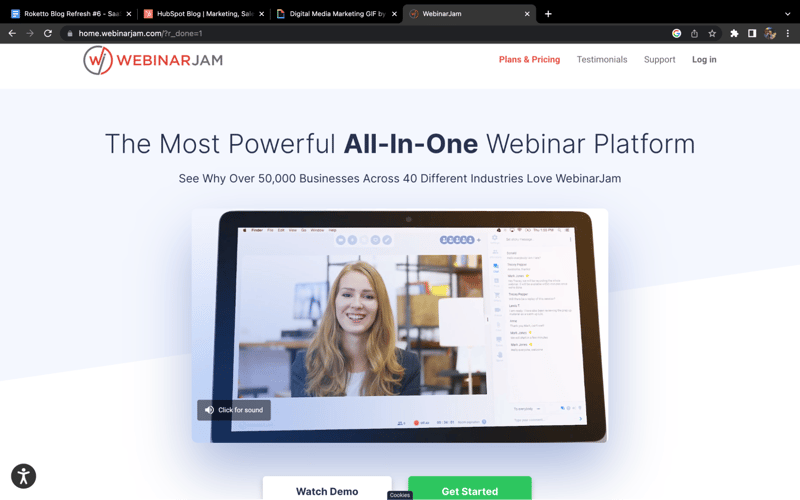
One of the biggest benefits of running a webinar is that once it's done and dusted, you can repurpose the recording as part of your content marketing strategy. An old live webinar can become a:
- Video guide
- On demand webinar
- Blog post or eBook (transcribed and edited)
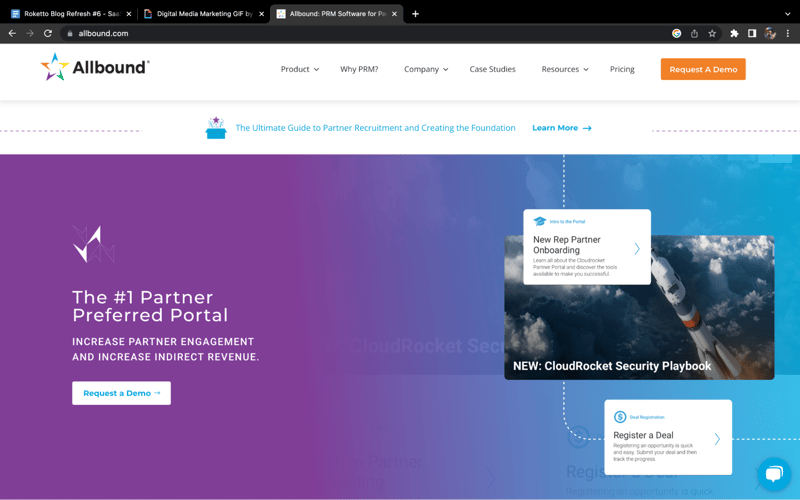
Website Landing Pages
Whether you're focusing on organic traffic through content marketing, paid social media campaigns, or extensive email marketing programs, chances are you're directing prospects through to your website.
If that's the case, then it's absolutely vital that your website is optimized for lead conversion. Conversion optimization is an entire field in itself, but here's a few tips from the pros that will get you started.
Install An Exit Intent Popup
Have you ever been browsing a website, and as you move your cursor up to the top of the screen, a little popup box appears? That's called an exit intent popup.
Its function is simple: when the prospect moves to exit the window, the popup activates. It's kind of like your hail mary or website lead generation. What exactly is in the box is entirely up to you, but it's generally a good idea to give something away for free that is of insane value (such as a free email course).
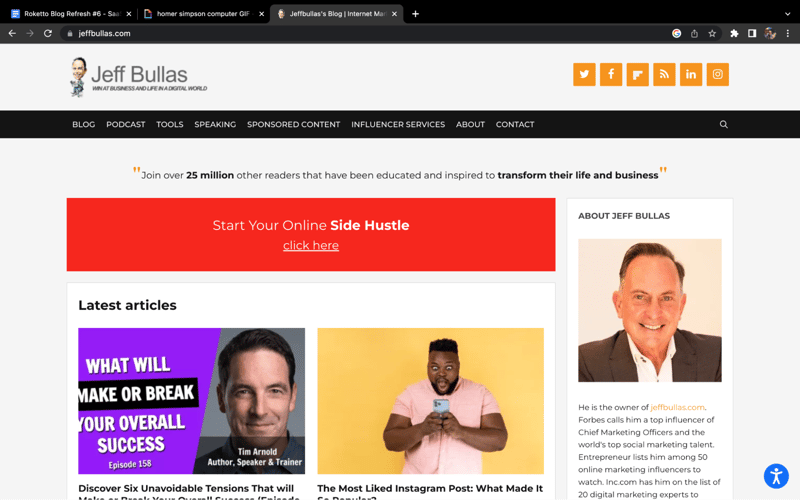
You should consider having different exit intent popup windows for different web pages. Your offer might be different if the customer is exiting a blog page (e.g. subscribing to our blog) than if they are leaving a product page (e.g. how about a free trial?).
Get Your Customers Talking With A ChatBot
You should think of your ChatBot as your virtual store assistant.
In the brick-and-mortar store model, customers are generally greeted by a salesperson or customer service rep who offers to help them find their way around. Even if they are “just looking”, that rep is always there to help them. Your ChatBot is the digital version of this.
You can set up a ChatBot to be able to answer a number of common questions or to guide the prospect to their area of need. ChatBot can't answer that question? Give us your email, and we'll get back to you. Cha-ching!
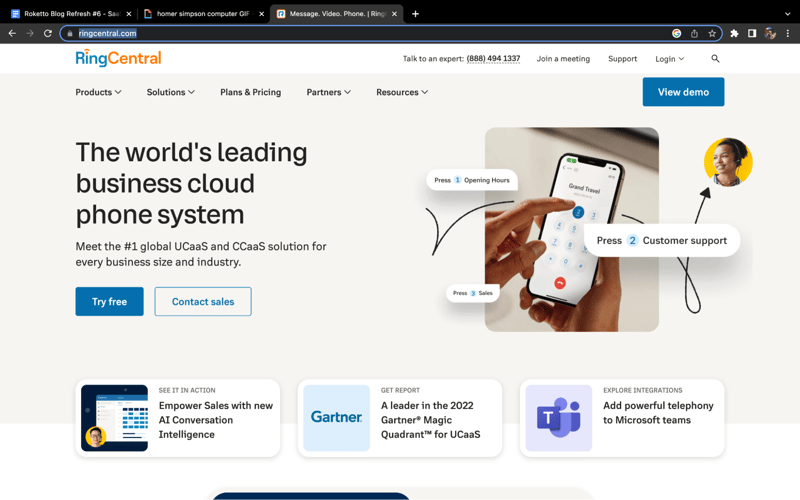
Tried And True - Free Trial
What better way to capture a hot bottom-of-funnel lead than with a free trial?
Not only is this a perfect way to capture some prospect details, but it also gives them a chance to go deep into your product and really determine if it works for them. If the trial lasts long enough, they'll begin embedding it into their company processes, which turns a maybe into a yes every time.
Plus, it gives your salespeople a great reason to engage. I see you activated a trial Mr. Customer, how about a free demo too? Let me show you around…
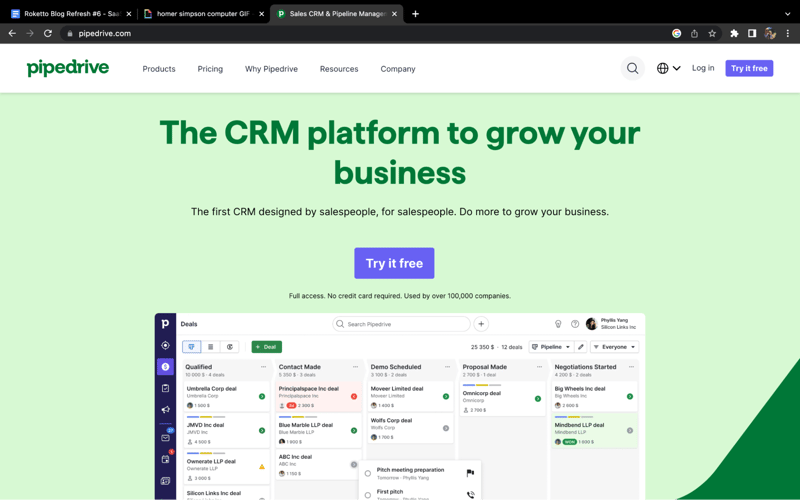
The way to maximize your conversion of free trials into paying customers is by helping them actually use your software. It's one thing to click a “Try it free” button, but it's another to actually spend some time diving deep.
Offering a free demo with a sales rep is a great way to do this, plus it can be a strong indicator of how serious the prospect is. You should also create some quality content to help guide them through using your product.
Video works best here, as you can show prospects exactly what they need to be looking at, and they can experiment and follow along in real time. SaaS customer onboarding best practices, such as streamlining the adoption process with as much helpful resource as possible, boosts the user experience and decreases the time it takes for the customer to understand the system.
Email Marketing Ain't Dead
Yes, everyone's having a hack at email right now.
Slack is calling itself the “alternative to email,” InMail is killing email in response rates, and some companies are even going back to physical mailouts. Okay, to be fair, those are probably the same guys twirling their moustaches, drinking craft beers and listening to their favourite indie artists on vinyl, but you get the point.
The truth is, though, email marketing is still an incredibly lucrative field. The ROI is insane, and you can get some pretty sweet open rates if your headlines are strong.
So how exactly can you get results out of email marketing for your SaaS company?
Put a CTA In Your Email Signatures
You're sending tens if not hundreds of emails a day. Multiply that by the 30 people in your office, and that's an easy 3000 emails sent every day. If you don't have a solid call to action built into your email signatures, you're missing out on an opportunity.
Of course, you don't want to overcrowd your signature. You've no doubt already got your social media links in there as well as your contact details. So keep it simple. Add a link to subscribe to your blog or to sign up for a free trial.
Ask For Email Signups EVERYWHERE
It goes without saying that you should avoid going overboard. Nobody likes having to wade through endless popups to access a website. But you can be more subtle than that and still include several CTAs in your marketing content.
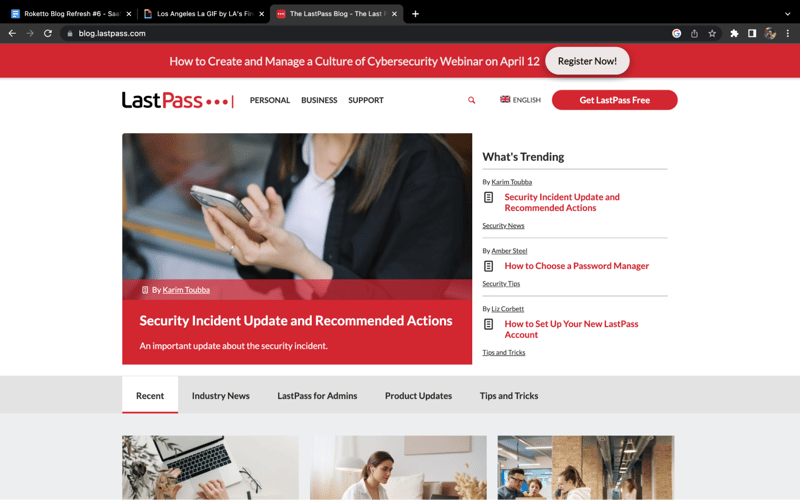
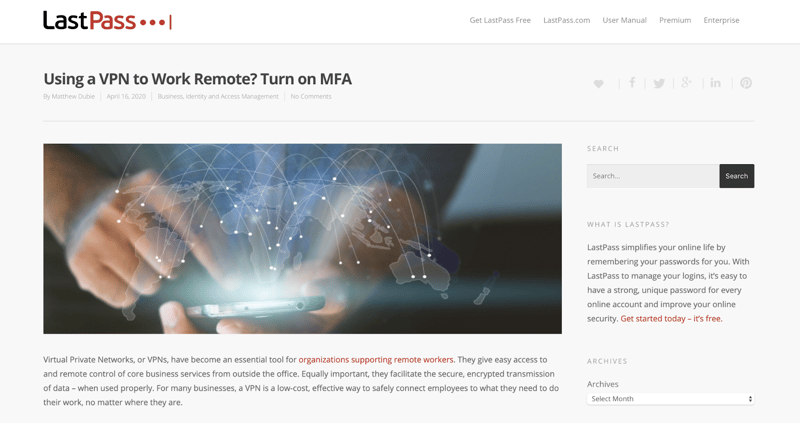
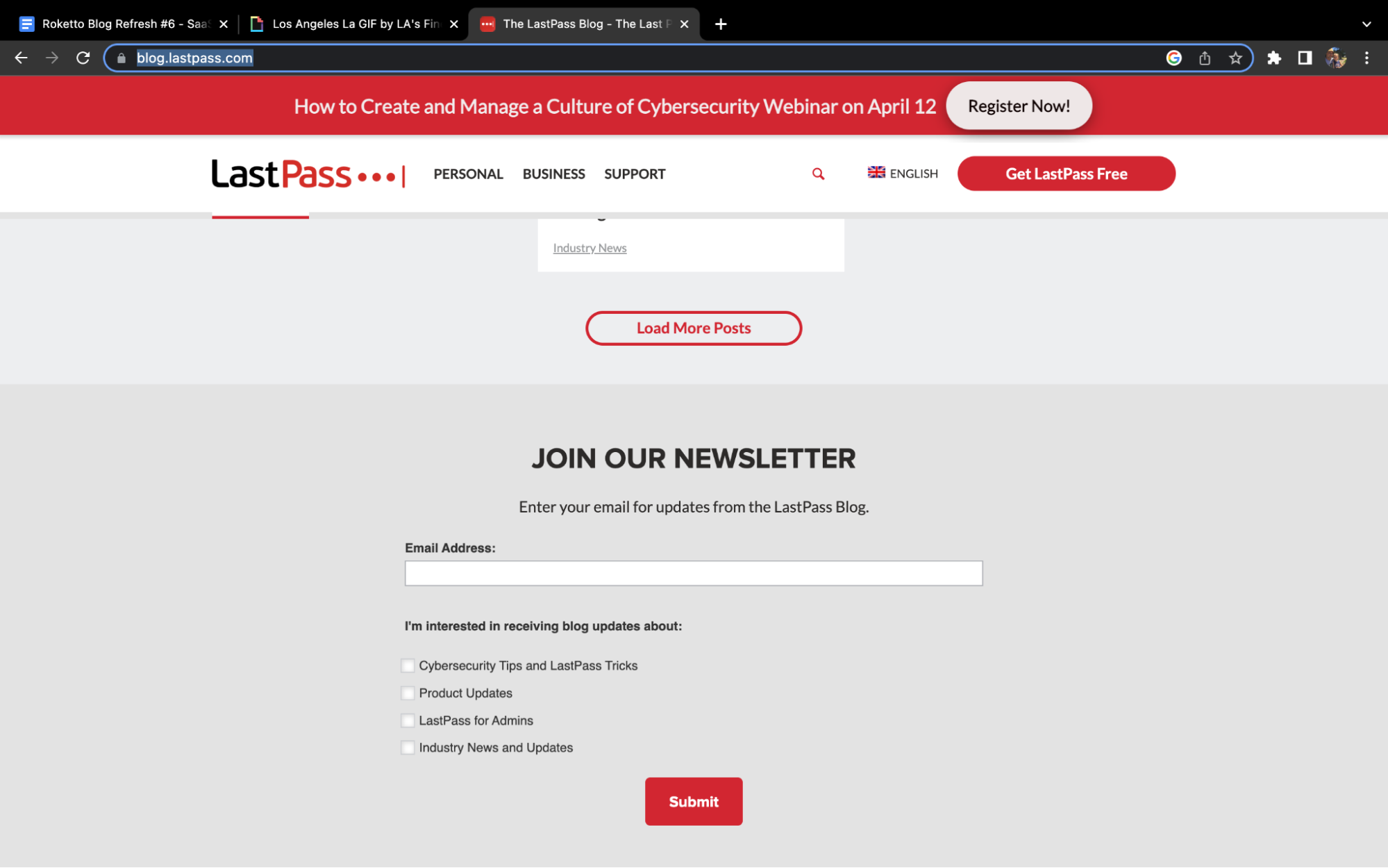
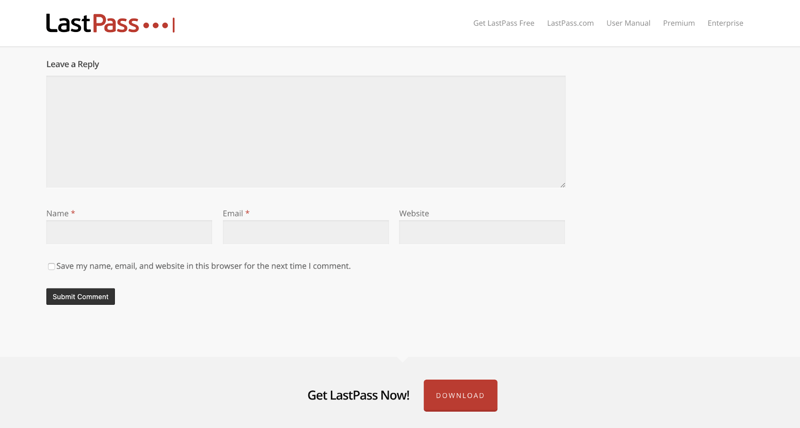
The above is a single blog post from LastPass. There are a total of four CTAs on this page which all require an email address, and they've done this without intrusive pop-up ads.
Create An Email Drip Campaign
At some point or another, some of your prospects are going to fall out of the pipeline. Whether they decided against making a purchase or they decided to go with a competitor, you'll inevitably have a percentage of leads that just don't turn into a yes and might never get a definitive ‘no.'
But all is not lost. Even prospects that went with a competitor can still turn into paying customers in the future, so don't give up on them yet.
Instead, create an email drip campaign that slowly but surely shows them you're the company they need. At some point or another, their current solution just won't cut it, and you'll be there waiting like the granny who stalks the slot machines waiting for some to give up, then swoops in to take the jackpot.
These drip campaigns should be less intense and less frequent than your conversion-focused campaigns. Once a month should do the trick, and focus on providing as much value as you can in that one email rather than simply emailing for the sake of it.
For example, invite them to your upcoming webinar.
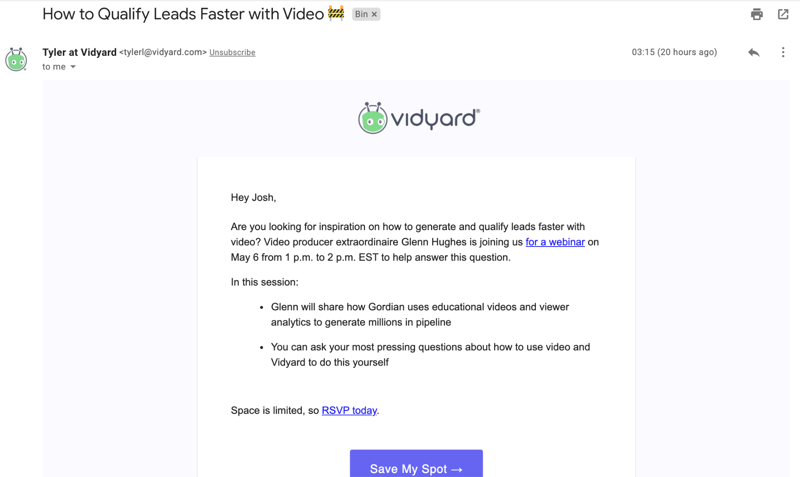
Use Case Studies or Testimonials
Without testimonials or case studies, your SaaS lead generation efforts would be pointless. These articles or infographics help demonstrate your software's real-world impact, building credibility and trust with prospects.
Here are ways to effectively use case studies or testimonials for SaaS lead generation:
- Be specific and results-driven
- Highlight success stories
- Utilize different formats and styles
- Share content across multiple channels
- Use real customers but get permissions first
If you're looking for a powerful way to boost your SaaS lead generation, leveraging testimonials and case studies is the answer. Potential clients need to envision the value of your software, and this social proof will assist with that.
B2B SaaS Lead Generation Strategies for Social Media
To be successful in SaaS marketing, you've got to choose your channels wisely. Remember, you're marketing to business decision-makers, so you're probably not going to reach your target audience on platforms like Snapchat and TikTok.
That doesn't mean you should write off social media altogether. Far from it.
There are still many social media platforms that work very well for SaaS lead gen. LinkedIn is the obvious choice, being fairly business-focused in nature, but you should also consider using Twitter and even Facebook depending on your customer personas.
Tools like Linked Helper can enhance your SaaS lead generation efforts by automating tasks on LinkedIn, such as targeted connection requests and personalized outreach messages. This tool streamlines your engagement on the platform, ensuring a more efficient and effective approach to building connections and generating leads within the business-focused environment of LinkedIn.
In-Stream Ads
In-stream ads are what most users see when they're scrolling through Facebook or LinkedIn.
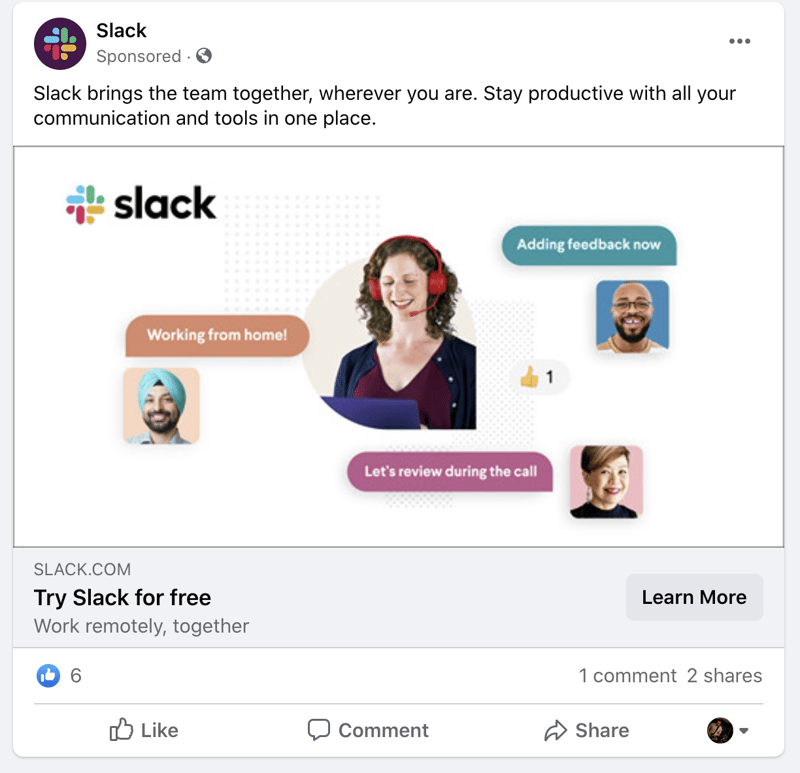
Most SaaS companies use in-stream ads as a form of native advertising based on their customer personas. This tactic pushes ads out to users that match the criteria you've set such as interests, occupation, and location.
You can also use Facebook or LinkedIn's pixels to track your website traffic and then remarket directly to those prospects! That's exactly what happened in the above example, I was just on Slack's website and only minutes later received a targeted ad in my Facebook feed.
You can also use these pixels to create what's known as a lookalike audience. That's basically where you say, “Hey, Facebook, see these people who have been on my website? I want you to find other people just like them (demographics, interests etc.) and show them this ad.”
The theory behind this is that you're more likely to have your ad shown to highly relevant people if they are similar in several aspects to prospects who have already shown an interest in you.
To use social media successfully for lead generation, your ad needs to be pushing viewers toward a specific call to action.
The best way to do this is to encourage viewers to click through to a specific landing page with the aim of converting the prospect into a lead on your website.
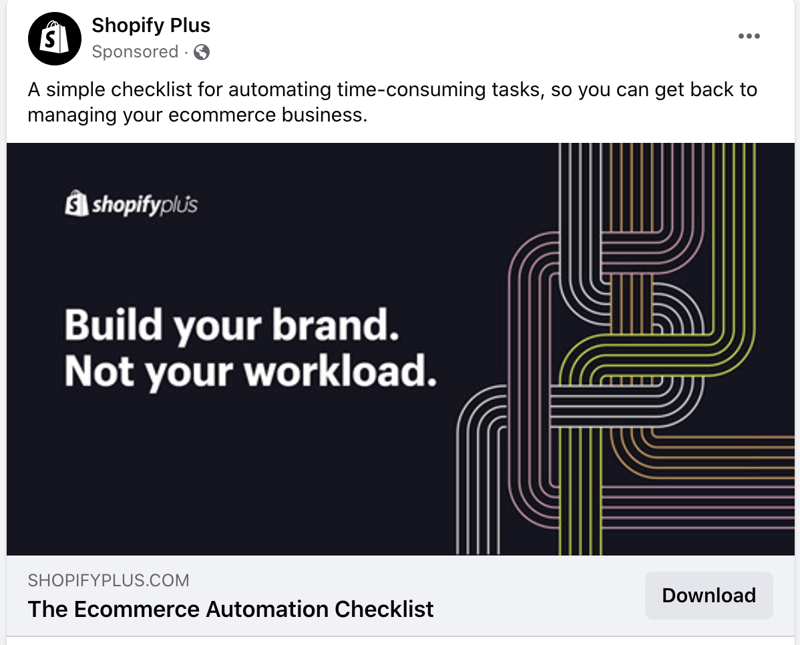
It's generally more cost-effective than form-fill lead capture goals, and you deliver a lot more information on a landing page than you can in an in-stream ad.
LinkedIn InMail
LinkedIn's InMail function works a little bit differently from in-stream ads. It's like sending an ad directly to someone's inbox, as opposed to displaying it within their social feed.
Yes, it's a slightly more aggressive technique, but it gets sh*t done. LinkedIn InMail has a response rate 300% higher than emails using the same content.
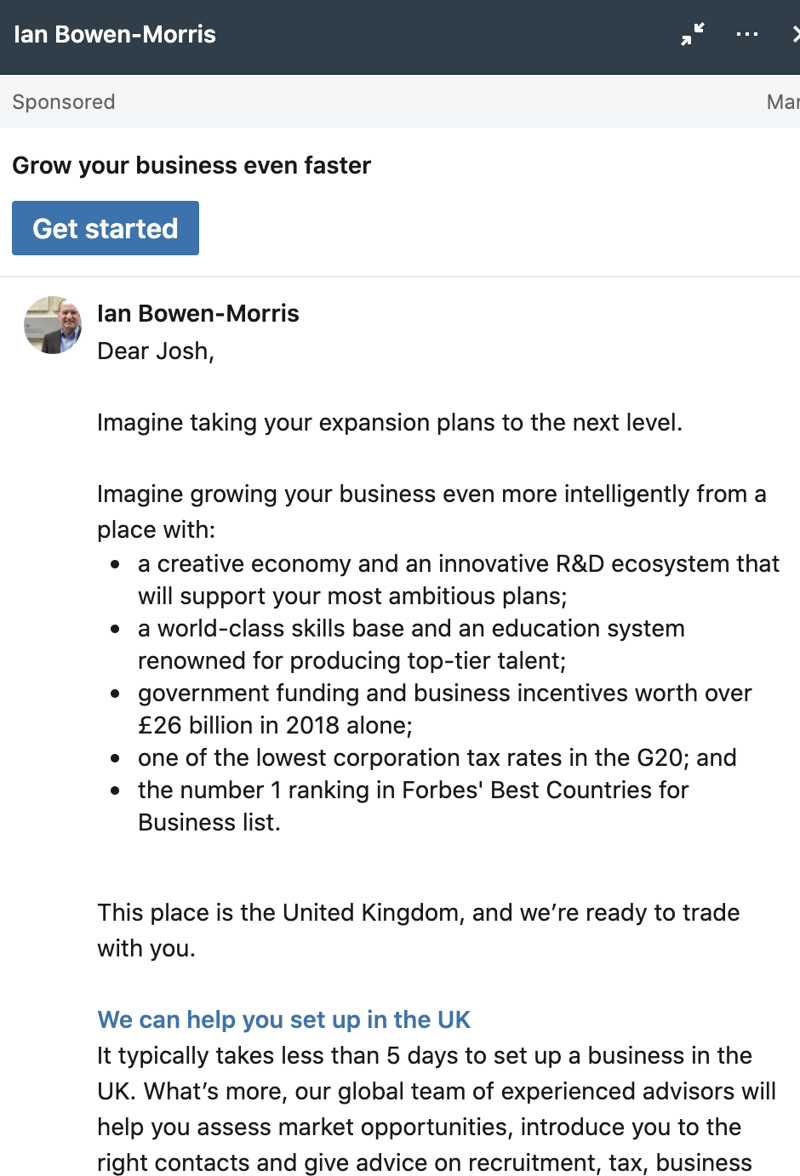
Track Your Lead Generation Strategy KPIs
Monitoring your SaaS lead generation strategy's key performance indicators (KPIs) is like having a compass that keeps you on track during a campaign. Tracking and measuring these KPIs allow you to make data-driven decisions, optimize marketing efforts, and ensure the SaaS lead generation efforts are fully utilized.
Start by identifying the most relevant KPIs for your SaaS business, such as the number of leads generated, conversion rate, cost per lead, and prospect quality. Set specific targets for each KPI to have a benchmark for success.
You can also streamline the tracking process and gain insights with tools such as:
- Marketing automation software
- CRM systems
- Analytics dashboards or SaaS reporting tools
Remember that SaaS lead generation is an ongoing process, and tracking KPIs allows you to optimize efforts for more profound results. Stay flexible and adapt strategies to ensure a successful SaaS lead generation campaign.
What to Consider Before Setting Up B2B SaaS Lead Generation Strategies
Know Your Target Audience
Understanding the target audience is critical for effective SaaS lead generation. Identify the customer, their pain points, and what motivates them to purchase. Analyze prospect data, perform market research, and create buyer personas to get a clear scope of the audience. These considerations can help you generate high-quality leads by tailoring your lead generation strategies that resonate with the potential customer.
Select Lead Generation Tools
The market is flooded with a plethora of lead-generation tools, ranging from social media automation platforms to email marketing software. It's vital to meticulously evaluate and choose the correct tools that align with your company's objectives and budget.
When selecting lead generation tools, it's important to think about the following factors:
- Pricing
- Integration capabilities
- Scalability
- Ease of Use
Some popular lead-generation tools include email marketing software, content marketing platforms, and customer relationship management applications.
Set Lead Qualification Criteria
Not all leads are created verbatim; defining lead qualification criteria is crucial to ensure you are targeting the correct potential clients. Build a list of attributes that align with your ideal customer profile (ICP) to filter out unqualified leads and concentrate efforts on high-potential prospects only.
Consider pain points, budget, locations, industry, and company size when setting up the lead qualification criteria.
Conclusion
Truly successful lead generation in SaaS comes from a multi-channel approach. Put all your eggs in one basket and chances are none of them will hatch. You've got to experiment, see what works best for your company, test, tweak, and try again.
Here's a summary of the lead gen tactics you can implement to see huge growth in your SaaS company.
|
Content Marketing |
Your Website |
Social Media |
Email Marketing |
|
Blog |
Exit intent popups |
In-stream ads |
Add a CTA to your email signatures |
|
Gated content |
ChatBot |
LinkedIn InMail |
Maximize your signups |
|
Webinars |
Free trials |
Boosted posts |
Drip campaigns |
Of course, there are plenty of other tactics you can apply, but these are the tried and tested ones that lead to SaaS success stories.
Tried a few and not getting anywhere? We're experts in SaaS lead gen. Let's chat!

Chris Onyett
Chris is one of the managing partners at Roketto. His area of expertise is digital marketing and loves sharing and educating on topics like Google Ads, CPC bidding tactics, Google Analytics, and marketing automation. When Chris isn't in the office, he enjoys playing volleyball, mountain biking, and hiking with his American Eskimo.










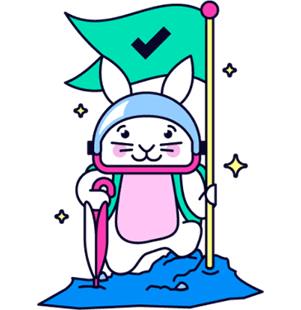


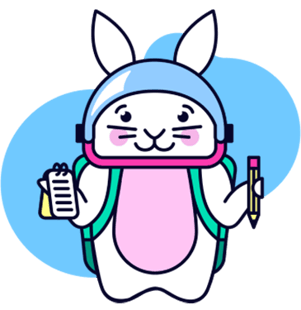


2.png)
2.png)




